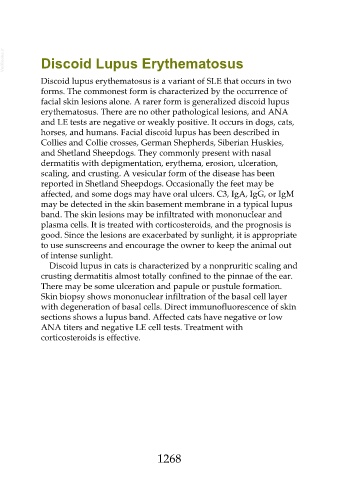Page 1268 - Veterinary Immunology, 10th Edition
P. 1268
VetBooks.ir Discoid Lupus Erythematosus
Discoid lupus erythematosus is a variant of SLE that occurs in two
forms. The commonest form is characterized by the occurrence of
facial skin lesions alone. A rarer form is generalized discoid lupus
erythematosus. There are no other pathological lesions, and ANA
and LE tests are negative or weakly positive. It occurs in dogs, cats,
horses, and humans. Facial discoid lupus has been described in
Collies and Collie crosses, German Shepherds, Siberian Huskies,
and Shetland Sheepdogs. They commonly present with nasal
dermatitis with depigmentation, erythema, erosion, ulceration,
scaling, and crusting. A vesicular form of the disease has been
reported in Shetland Sheepdogs. Occasionally the feet may be
affected, and some dogs may have oral ulcers. C3, IgA, IgG, or IgM
may be detected in the skin basement membrane in a typical lupus
band. The skin lesions may be infiltrated with mononuclear and
plasma cells. It is treated with corticosteroids, and the prognosis is
good. Since the lesions are exacerbated by sunlight, it is appropriate
to use sunscreens and encourage the owner to keep the animal out
of intense sunlight.
Discoid lupus in cats is characterized by a nonpruritic scaling and
crusting dermatitis almost totally confined to the pinnae of the ear.
There may be some ulceration and papule or pustule formation.
Skin biopsy shows mononuclear infiltration of the basal cell layer
with degeneration of basal cells. Direct immunofluorescence of skin
sections shows a lupus band. Affected cats have negative or low
ANA titers and negative LE cell tests. Treatment with
corticosteroids is effective.
1268

